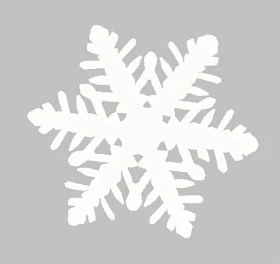Bentley was born on February 9, 1865, in Jericho, Vermont. He first became interested in snow crystals as a teenager on his family farm. He tried to draw what he saw through an old microscope given to him by his mother when he was fifteen. The snowflakes were too complex to record before they melted, so he attached a bellows camera to a compound microscope and, after much experimentation, photographed his first snowflake on January 15, 1885.
He would capture more than 5,000 images of crystals in his lifetime. Each crystal was caught on a blackboard and transferred rapidly to a microscope slide. Even at subzero temperatures, snowflakes are ephemeral because they sublime.
Bentley poetically described snowflakes as "tiny miracles of beauty" and snow crystals as "ice flowers." Despite these poetic descriptions, Bentley brought a highly objective eye to his work, similar to the German photographer Karl Blossfeldt (1865–1932), who photographed seeds, seed pods, and foliage.
Bentley's work gained attention in the last few years of the nineteenth century, after his work was first published in a magazine by Henry Crocker of Fairfax, Vermont; who consequently ended up with the largest private collection of Bentley's works. Harvard Mineralogical Museum acquired some of his photomicrographs. In collaboration with George Henry Perkins, professor of natural history at the University of Vermont, Bentley published an article in which he argued that no two snowflakes were alike. This concept caught the public imagination and he published other articles in magazines, including National Geographic, Nature, Popular Science, and Scientific American. His photographs have been requested by academic institutions worldwide.
In 1931 Bentley worked with William J. Humphreys of the U.S. Weather Bureau to publish Snow Crystals, a monograph illustrated with 2,500 photographs. His other publications include the entry on "snow" in the fourteenth Edition of Encyclopædia Britannica.
Bentley also photographed all forms of ice and natural water formations including clouds and fog. He was the first American to record raindrop sizes and was one of the first cloud physicists.
He died of pneumonia at his farm on December 23, 1931, after walking home six miles in a blizzard. Bentley was memorialized in the naming of a science center in his memory at Johnson State College in Johnson, Vermont. Shortly before his death, his book Snow Crystals was published by McGraw/Hill and is still in print today.
He would capture more than 5,000 images of crystals in his lifetime. Each crystal was caught on a blackboard and transferred rapidly to a microscope slide. Even at subzero temperatures, snowflakes are ephemeral because they sublime.
Bentley poetically described snowflakes as "tiny miracles of beauty" and snow crystals as "ice flowers." Despite these poetic descriptions, Bentley brought a highly objective eye to his work, similar to the German photographer Karl Blossfeldt (1865–1932), who photographed seeds, seed pods, and foliage.
Bentley's work gained attention in the last few years of the nineteenth century, after his work was first published in a magazine by Henry Crocker of Fairfax, Vermont; who consequently ended up with the largest private collection of Bentley's works. Harvard Mineralogical Museum acquired some of his photomicrographs. In collaboration with George Henry Perkins, professor of natural history at the University of Vermont, Bentley published an article in which he argued that no two snowflakes were alike. This concept caught the public imagination and he published other articles in magazines, including National Geographic, Nature, Popular Science, and Scientific American. His photographs have been requested by academic institutions worldwide.
In 1931 Bentley worked with William J. Humphreys of the U.S. Weather Bureau to publish Snow Crystals, a monograph illustrated with 2,500 photographs. His other publications include the entry on "snow" in the fourteenth Edition of Encyclopædia Britannica.
Bentley also photographed all forms of ice and natural water formations including clouds and fog. He was the first American to record raindrop sizes and was one of the first cloud physicists.
He died of pneumonia at his farm on December 23, 1931, after walking home six miles in a blizzard. Bentley was memorialized in the naming of a science center in his memory at Johnson State College in Johnson, Vermont. Shortly before his death, his book Snow Crystals was published by McGraw/Hill and is still in print today.
- Snowflake Bentley.com
- Bentley Snow Crystal Collection of the Buffalo Museum of Science
- Works by or about Wilson Bentley in libraries (WorldCat catalog)
- Inventory of Wilson A. Bentley Photographs, Special Collections, University of Vermont Library
- Inventory of Wilson A. Bentley Photographs, Smithsonian Institution Archives, Smithsonian Institution
- Wilson A. Bentley Photographs at the Vermont Historical Society
- Smithsonian Photography Initiative, click! photography changes everything project story on Wilson A. Bentley
- Bliss, Segment on Bentley Snow Crystal Starts at 34:00
Now that you've cut a snowflake, why not draw a snowman? Here is a step-by-step way to make two little children playing in the winter weather. Draw them with their snow friend by first drawing 7 circles. Then draw more details - a broom, a shovel, a top hat and faces...
 |
| Simple steps to draw children building a snowman. |















No comments:
Post a Comment
Constructive comments are appreciated. All comments are moderated and do not immediately appear after publishing. I don't publish spam folks. Thanks and have a nice day!